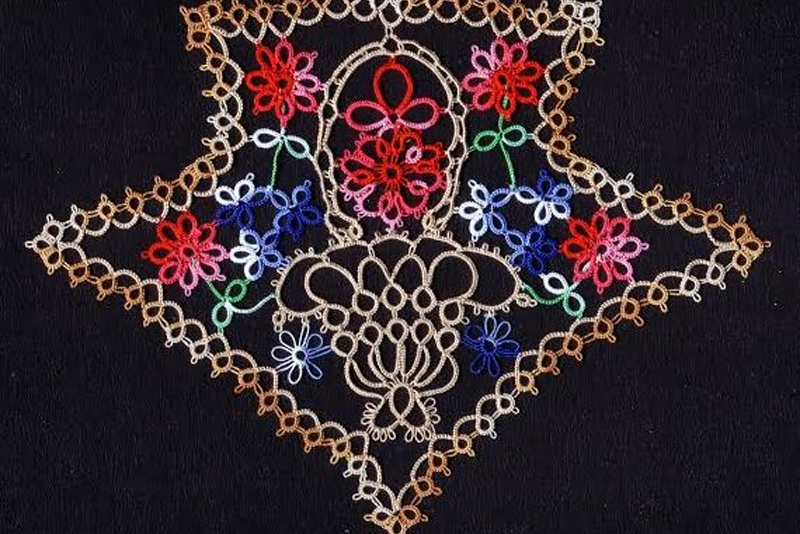Barbara Hevener has cleared up a bit of confusionj for me about Mary E. Fitch Tatting Series #6 1916. When I posted that book for public domain use: http://www.georgiaseitz.com/public/maryfitch/maryfitch6cover.jpg http://www.georgiaseitz.com/public/maryfitch/maryfitch6insidecover.jpg http://www.georgiaseitz.com/public/maryfitch/maryfitch6pg4.jpg I included instructions to replace the number 4 in the above link with numbers 5 through 21. Each page of the book is displayed on one page separately. There are 20 pages counting the covers. And I noted that if anyone had an original copy of the book, I would be most grateful for pages 2 and 3.
Barbara had a copy (which she believes--from its appearance and authentic musty odor--to be an original 1916 edition). She reports that she did not see any pages explicitly numbered 2 and 3. Instead, she believes that the publisher may have used an old style of page numbering wherein the outside front cover was considered to be page 1, the inside front cover (diagrams for positions No. 1 through 7, list of colors, and Abbreviations Used in Tatting) was considered to be page 2, the following page (descriptions of Tatting and Roll Tatting) was considered to be page 3, and page 4 was the first page to bear an explicit page number. Barbara also notes that this same style of page numbering appears to have been used in the Mary Fitch #8 book (Crochet and Tatting Yokes & Collars) published in 1917--although in that book, page 3 is the first to bear an explicit page number.
Barbara noted, too that some of the later Mary Fitch books appear to have an even stranger page-numbering scheme wherein advertising pages inserted into the binding near the front of the book are separately numbered and prefixed by the letter "I" (for example, page number I1, I2, or I3), but the specific "rules" for counting the cover pages, etc., seem inconsistent from one book to the next. Many thanks for this information.
Here are some headlines from the past.
"Don't Hang your tatting on the telephone lines on the switchboard" topic of lecture to new switchboard operators. Aberdeen American Jan. 18, 1917. Elsie H's tips for tatting:
"Here are two discoveries which may aid others in having tatting look well after it is sewed on, and also save time in sewing it on: I find that if tatting is ironed over a very rough Turkish towel the picots are much prettier, and all the tedious work of picking or pulling them out is avoided. When making tatting, try having the picots at the upper edge, or top, which are to be sewed to the cloth longer than the common picot; the work can then be held directly over the hem, and if it is basted, can be sewed on with the same stitching or felling that hems the material." The Plain Dealer Nov. 06, 1921. Tatting Fashionable in New York:
"...Though taffeta, peau de soie, louisine and the various other fashionable waist [blouse] materials will hold thier own in popular favor, advance models show an attempt to put in the ascendancy the silky light weight fabrics that have proved so smart this summer. Of course, the highly finished satins and the like will ever hold first place fro very dressy occasioins but they must be trimmed sparingly and by the gifted with a sense of the fitness of things if exxaggeration is to be avoided.
In the graceful voiles, etamines, hopsackings an canvas this danger is not so great. And speaking of trimming, happy will be the woman who has smoe bits of that old fashioned lace known as tatting stored away in the clothes' chest this fall for it is to be the decoration of the season. It will be used for yokes, elbow cuffs, pelerines and in every imaginable way to accomplsih original effects. SEveral of the bodices designed for the fashion show which opens next weel show unique garnitures of tatting...
...although there is no separate cuff and above this point to the elbow they [the sleeves] fall full and loose, trimmed with a band of tatting embroidery headed by three deep tucks that reach well nigh to the shoulders.
There is a yoke and vest of tatting done in cream thread and delicioulsy interwovern with embroidered leaves. This yoke extends below the bust-line in a perfect square and is finished with a fichu-like arrangment of the tatting draped low over the back and shoulders..." New York Fashion Letter from the Press and Horticulturist Sept. 11, 1903.
Here's the latest article from the Tatting site at BellaOnline.com.
Building a Tatting Library - Iris Niebach The books of Iris Niebach. Iris Niebach presents good strong traditional tatting patterns in her books. She often designs several smaller motifs which she then uses as the basic building block for several large and small doilies and lace pieces. http://www.bellaonline.com/articles/art26333.asp Please visit tatting.bellaonline.com for even more great content about Tatting. To participate in free, fun online discussions, this site has a community forum all about Tatting located here - http://forums.bellaonline.com/ubbthreads.php?ubb=postlist&Board=39 I hope to hear from you sometime soon, either in the forum or in response to this email message. I thrive on your feedback! Have fun passing this message along to family and friends, because we all love free knowledge! Georgia Seitz, Tatting Editor http://tatting.bellaonline.com One of hundreds of sites at BellaOnline.com







